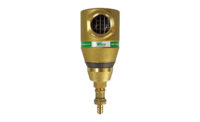AHR Expo 2019: Trends and themes from the show floor
Manufacturers tout efficiency and simplicity in newest products.

HVACR manufacturers reported positive 2018 sales growth according to the latest AHR Expo and ASHRAE Journal Annual Economic Outlook Survey, and 87% of respondents anticipate positive business prospects this year. Photo courtesy of AHR Expo.
High efficiency boilers, water heaters, and pumps — and products designed to avoid bottlenecks caused by the skills gap — were the name of the game at AHR Expo in Atlanta this week. The annual HVAC convention gathered from Monday to Wednesday at the Georgia World Congress Center, attracting thousands of attendees and exhibitors from across the globe to two large convention halls.
All-in-one systems
Manufacturers showcased turnkey solutions — plug-and-pump systems designed for easy installation in the field. It’s a solution to the skills-gap issue afflicting the contracting and construction industry. If there is a lack of experts trained to build component systems on site, a complete system of pumps, controllers, and other products simplify the job.
“We need to start thinking about how we modernize HVAC systems,” said Ashley Zachry, marketing segment manager, commercial and fire, Grundfos. “It doesn’t have to be a component system.”
Grundfos newest volley into the plug-and-pump arena is the Hydro MPC HVAC, a packaged pumping system for hot and chilled water applications. This fully integrated system arrives at the jobsite with pump, motor, variable frequency drive, and controller, pre-tested at the factory.
From the water heating side, Rinnai promotes its Tankless Rack System with the promise of heating right out of the crate. It also showed its newest product, the Duo 2, which combines the hybrid technology of the Demand Duo product family with the redundancy and performance of its commercial rack systems. The system features a 119-gallon storage tank along with two CU199 Rinnai Tankless Water Heaters that work together to offer both tank and tankless technology.
“They don’t want to assemble (heaters) in-field,” said Dale Schmitz, commercial marketing manager at Rinnai. “They just need a pump and gas, and it’s ready to go. There’s a lack of skilled labor out there, and anything we can do to simplify service and repairs (has) really shown in our sales.”
PEX and pipe fitting
PEX continues to expand its footprint. The show floor was full of new products designed to help ease the connections between PEX and incumbent pipe materials. Legend premiered its Smartclick fitting that permanently clamps PEX pipes together without crimping, cinching or expansion tools.
Uponor debuted ProPEX copper press adapters in sizes from 0.5 inches to 3 inches. The lead-free adapters connect ASTM F1960 PEX to copper press piping systems. These adapters reduce overall project timeline by an average of 71%, compared to sweat, according to Uponor, and don’t require new tools or processes.
Again, the lack of qualified workers has led to a focus on crimping and pressing, rather than sweating or soldering.
“It’s easier to teach someone to crimp rather than to solder,” said Milwaukee Valve president Jim Vogel. And it’s much faster. Connecting two pipes via sweating could take 40 minutes, versus 12 minutes for crimping, he said.
Ergonomics and ease-of-use
With a crowded field of boiler and water heater makers, the little things count. LAARS’s Magnatherm HTD is highly efficient and features a new variable speed drive, but it’s also specifically designed to fit in an elevator, rather than requiring a crane to bring it to the top of large commercial buildings.
Another new heater at the show, Mestek’s FlexCore, features up to 99% maximum efficiency, according to the company, and it is 95%-plus AHRI certified and designed with ease-of-installation in mind.
“One of the best things about the FlexCore is the simplest thing,” said Chad Sime, director of sales and marketing for Mestek’s boiler group. “It’s got a light in the cabinet so that it makes it extremely easy … for building automation to come in and lay their wire and for the technician to work on the boiler.”
Human interfaces also improved this year. Navien introduced its new NFB-C commercial fire tube boiler in two sizes, NFB-C-301 (299,900 BTU/H) and NFB-C-399 (399,900 BTU/H). It uses the same patented stainless-steel fire tube technology from the NFB series released in 2018. The commercial fire tube boiler features a 15:1 turndown ratio, BACnet or LonWorks to BMS communication capability, top and bottom water piping connections, and a digital display.
“It’s an intuitive display, line-by-line capable of scrolling through to check anything you want from all the operation parameters to understand at what firing rate it’s going at, and what its potential outputs are,” said Brian Fenske, director of commercial sales at Navien.
Energy conservation
Pump makers are using ECM motors and variable speed drives to achieve upcoming DOE requirements that go into effect Jan. 27, 2020. To meet those requirements, Taco showcased its new Optimized Efficiency (Oe) high-performance package for commercial pumps at the show. Pumps between three and 30hp are available with the Oe package.
Several brands offered new electric water heaters and boilers, designed for regions with clean energy initiatives that encourage electricity generated through wind, solar or other sustainable methods for use powering plumbing applications on the grid, rather than burning gas in the boiler room. In addition to large electric boilers and water heaters, several manufacturers showed point-of-use electric water heaters for light commercial applications like nursing homes and office spaces.
Bringing a European innovation to American shores, Lochinvar released its new micro CHP cogeneration product, the XRGI25. It teamed with a Danish producer of residential and commercial combined heat and power products to launch the system. Using an internal combustion natural gas engine, micro CHP is designed to be an efficient and easy-to-install system intended for light commercial use. Using natural gas as a fuel, a commercial facility with the XRGI25 can produce both energy-efficient heat for domestic hot water and electricity to reduce energy consumption from external power sources. It’s aimed at regions with high “sparkspread,” meaning where natural gas costs are low but electricity prices are high.
At a press conference Monday, Armstrong Fluid also reiterated its “2 By 22” pledge to reduce greenhouse gas emissions among its installed customer base by 2 million tons by the year 2022. It’s at “the heart of what we do,” said Armstrong Fluid Technology Communications Manager Steve Lane.
To view more than a dozen video demos of products from the floor, visit pme here on Facebook.
Looking for a reprint of this article?
From high-res PDFs to custom plaques, order your copy today!






